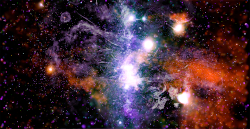 HEAPOW: Threading the Center (2021 Jun 07)
HEAPOW: Threading the Center (2021 Jun 07)
Earth is very far from the center of our Galaxy. That's a good thing. The center of the Milky Way is a dangerous place, packed with deadly massive stars (ticking time bombs which produce dangerous, high intensity UV radiation before exploding) along with lots of X-ray emitting neutron stars, and tons of black holes too (including, of course, Sgr A*, a four million solar mass monster at the Galaxy's dead center). But viewed safely from afar, these extreme objects make the center of the Galaxy a wondrously exciting place. Now a new study of the center of the Milky Way using radio and X-ray images provides the best view so far of the strange space near the center of the Galaxy. The image above shows a full-color high-resolution Chandra X-ray Observatory X-ray image of the a 1000 by 2000 lightyear region around the center the Milky Way. The X-ray image is colored orange, green, blue, purple, representing increasingly higher X-ray energies (and increasingly more extreme phenomena). The X-ray emission comes from stars and other individual sources, and also from large diffuse clouds of superheated, ionized gas. The composite image also shows a radio image by South Africa's MeerKAT radio telescope array, in white and gray. The radio image traces out long thin lines of gas which follow the magnetic fields threading through the inner part of the Galaxy, similar to the way the magnetic field of a child's magnet can be traced out using iron filings, or similar to the way hot gas traces out loops of magnetic field on the Sun. Scientists suspect that the release of energy stored in this Galactic magnetic field may play an important role in heating the center of the Milky Way, and perhaps driving cosmic rays.
CXC: Galactic Center: Magnetized Threads Weave Spectacular Galactic Tapestry
APOD: The Galactic Center in Stars, Gas, and Magnetism (2021 Jun 02)
viewtopic.php?t=41716
Chandra Large-Scale Mapping of the Galactic Centre: Probing
High-Energy Structures around the Central Molecular Zone ~ Q. Daniel Wang
- Monthly Notices of the RAS 504(2):1609 (Jun 2021) DOI: 10.1093/mnras/stab801
- arXiv.org > astro-ph > arXiv:2010.02932 > 06 Oct 2020 (v1), 26 Apr 2021 (v2)
| << Previous HEAPOW | High Energy Astrophysics Picture of the Week | Next HEAPOW >> |